2019 Wildlife Sightings: Incredible Findings and Photos
Welcome to the Kiawah Island Nature Program’s 2019 wildlife sightings page. Here, you’ll find postings from our Naturalists and island biologists showing you what is currently in the field as well as an archive of observations from throughout the year. We hope this site will get you excited about the amazing and diverse wildlife found on Kiawah. Get outside and share your photos and stories with us at Kiawah_Recreation@KiawahResort.com.
November 30, 2019 ~ The Sphinx
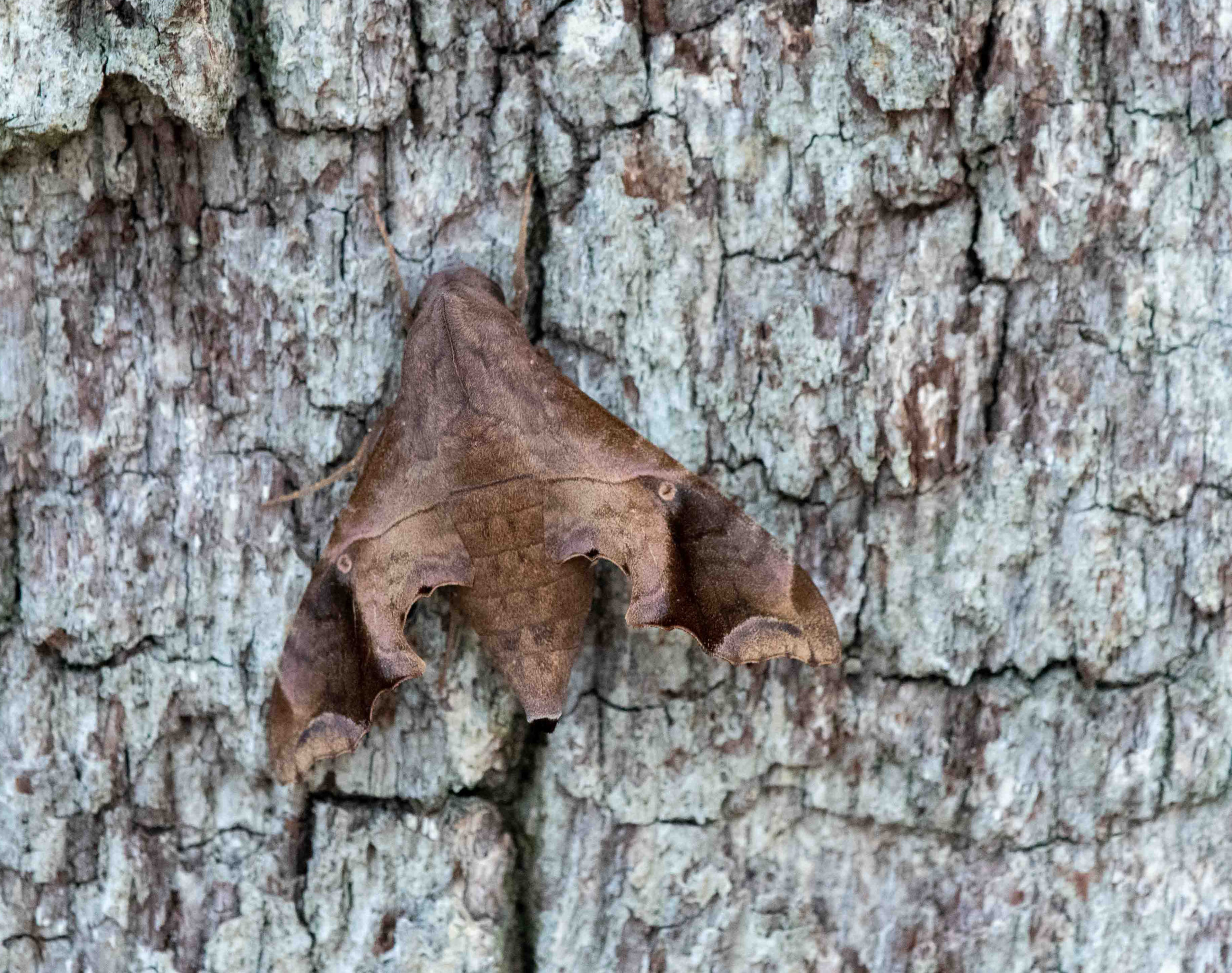
This bizarre looking moth was found by Naturalist Jake Zadik. It is known as a Mournful Spinx (Enyo lugubrious). They are commonly seen in flight during dawn and dusk this time of year. They have very rapid wing beats causing a blur as they move quickly from flower to flower. By day these adult moths rest on the side of a tree becoming almost invisible as their pattern and colors blend with the bark.
November 7, 2019 ~ Orange-billed, Oyster-eating, Winter Vacationers
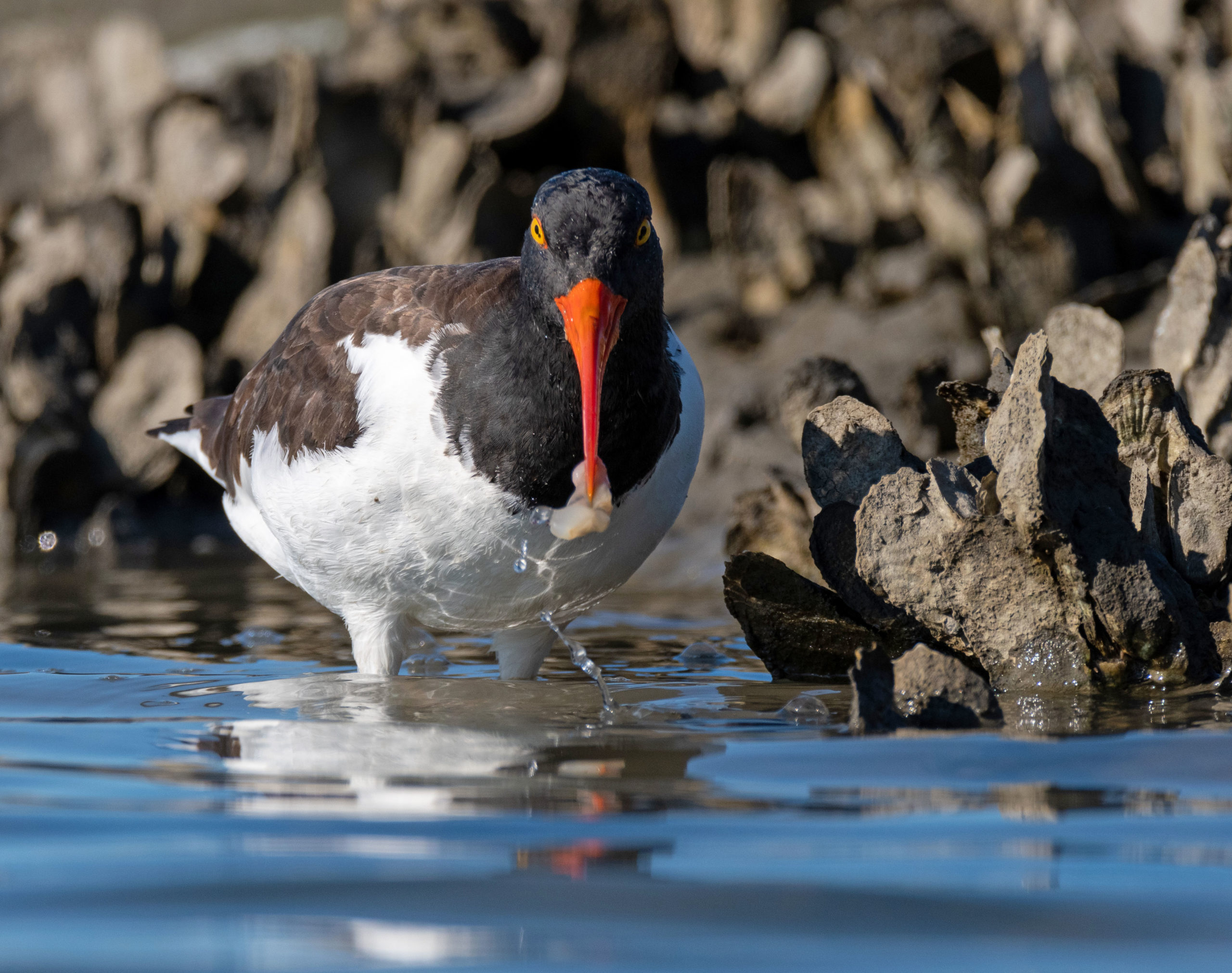
Naturalist Jake Zadik spent sometime out in Kiawah’s Marsh yesterday searching for American Oystercatchers. He strategically posted himself in a single location during a rising tide, and patiently waited as parcels of Oystercatchers flew in and forage on the oyster-beds around him. As they probed in the shallow water, sliding their long orange bills into slightly open agape oysters, Jake was able to scan their legs looking for colored bands. A few of the birds he observed had these bands, and the unique codes inscribed on the bands allow researchers to monitor their migration routes, their populations, and find important habitats for these fascinating birds. From this work, the American Oystercatcher Working Group has found that the marshes of South Carolina are the top wintering grounds for American Oystercatcher on the East Coast!
If you see any Oystercatchers with a band on their leg, please report it to the American Oyster Catcher Working Group. Photo taken by Naturalist Jake Zadik
September 19, 2019 ~ Warblers’a Migrating
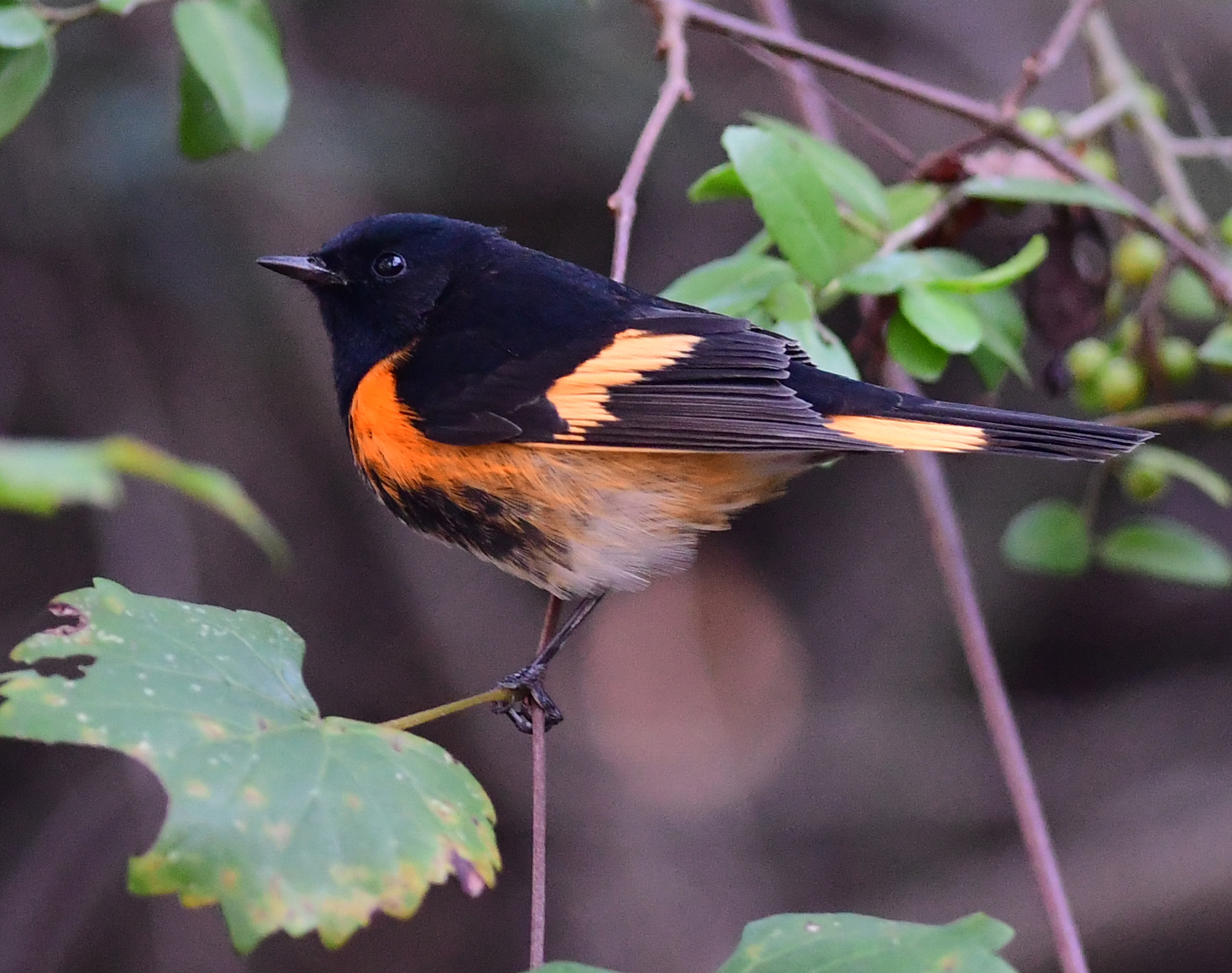
Fall means cooler weather. Cold fronts bring greater abundances of migrating birds. More birds equals better birding. Better birding increases happiness. Happiness increases life expectancy!
Many beautiful birds have been moving through South Carolina. The Back Island Birding trip today had a chance to see a Yellow Warbler, Common Yellowthroat, Black Throated Blue Warblers, and American Redstarts (pictured). Learn more about song bird migrations and see all the neat captures at the Kiawah Island Banding Station on their blog. Photo by Naturalist Jake Zadik
September 16, 2019 ~ Lookdown (Selene vomer).. Yep thats the name of a fish.

Our oceans are home to many beautiful and bizarre marine species. While cast netting, Naturalist Jake caught a rather interesting species of Jack. It had a silver body about the size of a quarter with yellow striping and long tendrils coming from both the dorsal and ventral fins; a juvenile Lookdown (Selene vomer). These beautiful fish can be found in both tropical and subtropical waters, and are very popular and desirable for saltwater aquariums. The most striking features of this juvenile are the vibrant colors and the long filaments on the dorsal spine that will be lost as it ages into a mature breading adult. This fish was most likely inshore hunting tiny pelagic crustaceans when it was caught. As they age, they will move offshore to spawn and continue into deeper waters in search of various prey items.
September 7, 2019 ~ Striped Burrfish
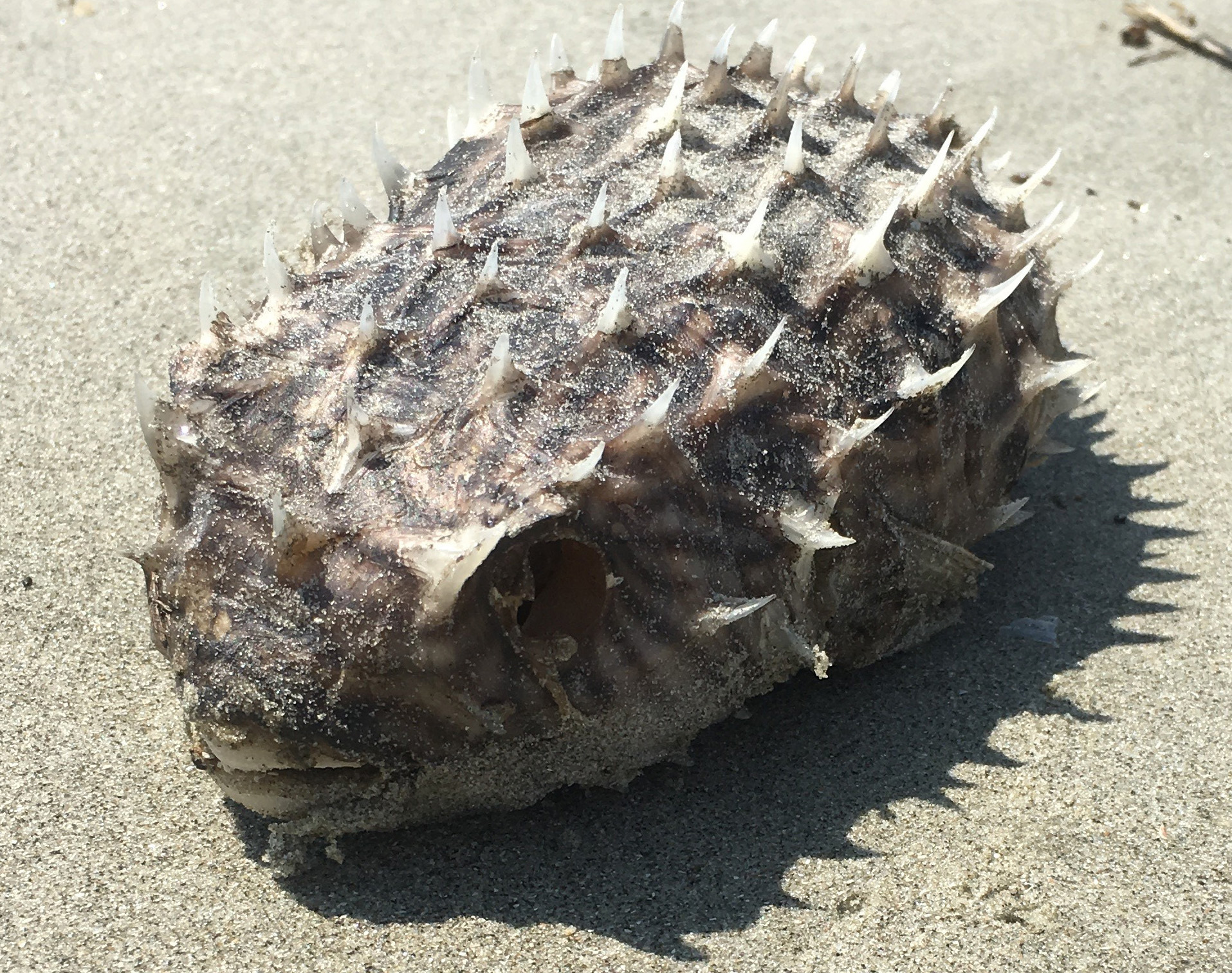
This Striped Burrfish was seen during a stroll on the beach after Hurricane Dorian rolled through South Carolina. This is a common species of fish in our inshore waters and Kiawah River. Check out those beak-like jaws! Using their strong jaws, they are able to easily crush their invertebrate prey such as whelks, quahogs, oysters, and barnacles. The Striped Burrfish is able to inflate its body by filling it with water or air. This is a method of self-defense used to deter predators and combined with spines that stand erect across their body, (which you can see in the photo) make this little fish not only look much larger, but much more unappetizing. Another interesting fact about the Burrfish is that it does not swim like any other fish! If you notice in the photo, it is very hard to see any fins on that fish. That’s because their pectoral and caudal fins are very small compared to the rest of its body size so it can only swim by waving its fins, not by using its entire body like the fish that we think of!
~Naturalist Meredith
August 29, 2019 ~ Dragonfly Migration is underway
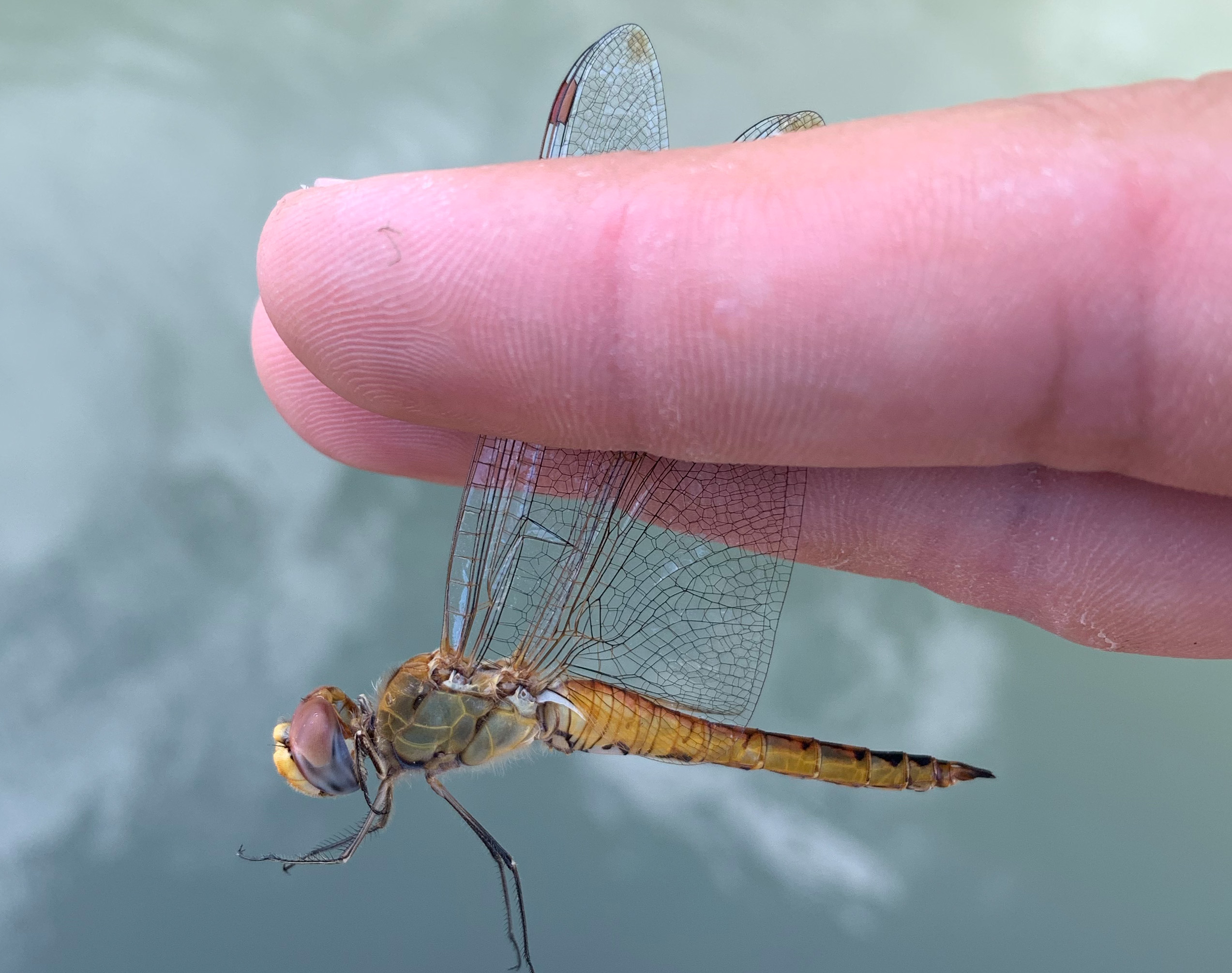
Yesterday there were few, and today there were swarms! The Wandering Glider (Pantela flavescens) has been deemed “the world’s most evolved dragonfly”. It has been found flying at heights higher than any other dragonfly. It has been found in the middle of the ocean by ocean freighters. And it travels longer distances than any other insect in the world! They are currently migrating southward and currently consuming almost any flying insect in sight at Mingo. A very neat species to observer indeed!
Specimen in the photo was captured by naturalist Megan and is being held by Naturalist Jake Z. Happy dragon hunting!
August 1, 2019 ~ Octopus
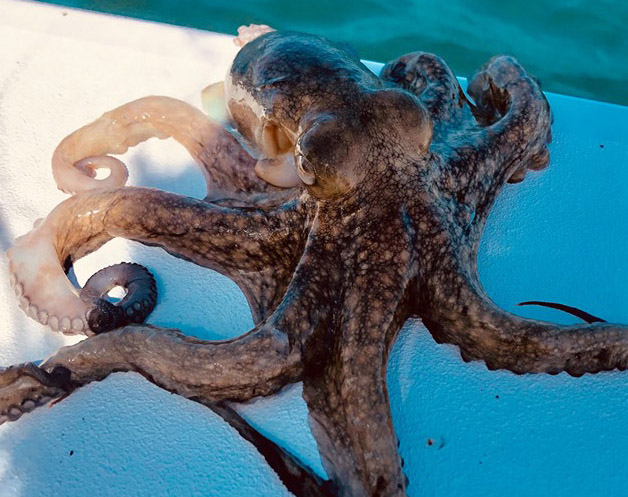
Anglers caught and released this octopus on a Near Coastal and Reef Fishing Charter with Captain John Ward.
July 26, 2019 ~ Barracuda
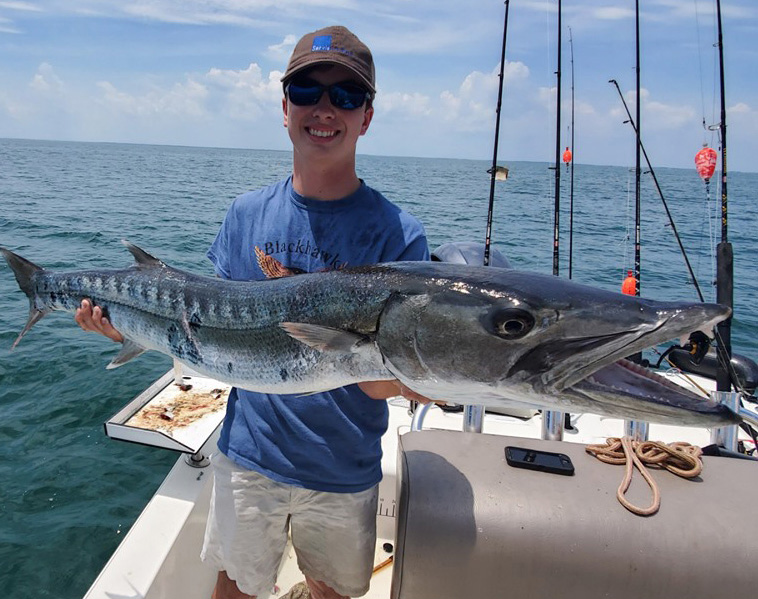
This Barracuda was caught with Captain Shane on a Near Coastal and Reef Fishing Charter. After a quick photo, the fish was quickly released back in the water.
July 26, 2019 ~ Bonnethead Sharks (Sphyrna tiburo)
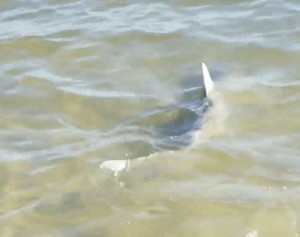
During our last several shelling trips to Botany Island, we have not only been able to find some amazing shells, but a beautiful Bonnethead shark as well! This species is in the same family as Scalloped sharks and Great Hammerhead sharks. They reach an average of 1.5 m (5 ft) in length and their head is “hammer-shaped” most likely to maximize the area of their sensory organs. These amazing sharks are really important for our environment and are completely harmless to humans unless provoked. Their favorite foods include crustaceans, bivalves, octopuses, and small fish. Observing one of these sharks is always a treat!
July 9, 2019 ~ Feather Report
It’s hot here on Kiawah Island, yet we’re still seeing birds. Despite the humidity today we were able to find 40 different species of our avian neighbors. We were immediately treated to crow copulation as we left the park. Seems safe to say that we can anticipate more Fish Crows here in the park. We were also treated to a half dozen juvenile green herons bearing fuzzy heads and speckled wings, each one cuter than the last. On the beach, we were pleasantly surprised to see more Least Terns than I’ve seen so far this year! Several were still in the throes of courtship. But, my favorite sighting today was a lone Wood Stork working the edge of one of our brackish ponds. We watched as the stork would approach the grassy edge, submerge its beak, then use one foot to stir up the mud below. As the foot mussed the mud, fish and shrimp fled, and at least one fish was unlucky enough to bump into the stork’s beak and be promptly turned into a Wood Stork meal. Our lists are below:
https://ebird.org/view/checklist/S58051538
https://ebird.org/view/checklist/S58051735
https://ebird.org/view/checklist/S58051862
June 18, 2019 ~ Feather Report
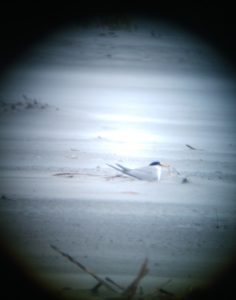
We had a splendid morning of birding today! Lots of variety as we navigated the island at our full moon high tide. We were first treated to a flock of roosting Wood Storks with a bonus Roseate Spoonbill. Then, we got some great, but fleeting, looks at a lovely adult male Summer Tanager as he worked the foliage for invertebrate breakfasts. Even more fleetingly, we spied hurtling hummingbirds flitting about. On the beach, we enjoyed some super cute sightings of the Least Tern chicks and were happy to see two additional nesting terns with eggs in their nests. And, to wrap it all up, we witnessed a gaggle of Least Bitterns sneaking around in the nearby marsh grasses. Everyone was out and about, busy after the morning showers.
The prevalence of the Least Tern nests out near the Ocean Course motivates me to remind everyone out on the Ocean Course side of the beach to be mindful of where you are walking! While there are designated “Nesting Areas,” terns don’t read, so they don’t always nest where we say they should. Please don’t walk up into the soft sandy zone to access the tide pool located between the two designated Nesting Areas. It’s currently not marked off by nesting signs, but it’s still a vulnerable place that’s valuable to the success of our local Least Tern colonies. Share the beach! Juliana Smith, Naturalist
eBird lists are below:
https://ebird.org/view/checklist/S57485906
https://ebird.org/view/checklist/S57485827
https://ebird.org/view/checklist/S57485669
https://ebird.org/view/checklist/S57485393
https://ebird.org/view/checklist/S57485346
May 28, 2019 ~ Feather Report
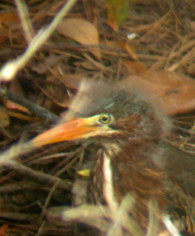
Today was a hot one! And yet, we still managed to see a lot of activity in bird world. We stumbled upon a pair of Great Crested Flycatchers carrying nesting materials. Fingers crossed they nest nearby where we saw them! We also saw some Blue Grosbeaks with nesting material flitting in and out of a sunflower patch – the colors were magnificent! And, my personal favorite, was the surprise sighting of a fledged Green Heron – still fluffy with baby feathers – as it stalked the pond edge. Our bird lists are below!
https://ebird.org/view/checklist/S56836529
https://ebird.org/view/checklist/S56836785
https://ebird.org/view/checklist/S56836944
May 9, 2019 ~ Feather Report

Even though we got drizzled on several times this morning, the birding was FANTASTIC. We practically stumbled into a black bird rookery, with dozens of nesting pairs including Red-winged Blackbirds, Common Grackles, and Boat-tailed Grackles. Most exciting of all was the discovery of an Orchard Oriole nest with the female incubating eggs and a male keeping a close watch nearby! Little baby birdie noises were a constant soundtrack to the morning. We were also treated to a breakfast drama as a Great Blue Heron caught and consumed a banded water snake pretty much as soon as we arrived to our first birding spot. Other highlights of the morning were striking, breeding plumage Green Herons and male Anhingas, a pair of Blue Grosbeaks carrying nesting materials, some chatty Cedar Waxwings, and, of course, the flashy adult male Painted Buntings. Juliana Smith, Naturalist
https://ebird.org/view/checklist/S56051884
https://ebird.org/view/checklist/S56052138
May 8, 2019 ~ Feather Report
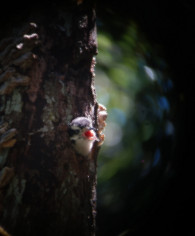
Here’s the bird list from this morning’s Birding for Beginners. Some highlights of the morning were excellent views of nesting Osprey and the lingering adult Bald Eagle along the parkway. The biggest highlight (for me!) was finding the Downy Woodpecker nest cavity near the center. We got these photos of who I assume is the adult that’s charged with sitting on the nest. He/she was calling as an adult would, versus the way a young bird might. Every now and then, the other adult would show up with snacks and fly away again. Babies are being had, partners are in need of snacks! https://ebird.org/view/checklist/S56002423. Juliana Smith, Naturalist
April 26, 2019 ~ Loggerhead Sea Turtle (Caretta caretta)
Kiawah’s first Loggerhead Sea Turtle nest of the season was laid last night. This was also the first nest in South Carolina and the earliest nest ever recorded in SC.
April 15, 2019 ~ Broadhead Skink (Plestiodon laticeps)
 Everyone is enjoying this warm weather, including our lizard friends! Kiawah is home to many different lizards: green anoles, eastern glass lizards, and multiple species of skinks, including this broadhead skink sunning at Mingo Point. Like other skinks, the young have bright blue tails and noticeable stripes. Broadhead skinks have powerful jaws for their size and like to feed on a variety of insects, spiders, and other invertebrates.
Everyone is enjoying this warm weather, including our lizard friends! Kiawah is home to many different lizards: green anoles, eastern glass lizards, and multiple species of skinks, including this broadhead skink sunning at Mingo Point. Like other skinks, the young have bright blue tails and noticeable stripes. Broadhead skinks have powerful jaws for their size and like to feed on a variety of insects, spiders, and other invertebrates.
April 12, 2019 ~ Captains Log
Captain Mike Waller just caught (and released) his first shark of the season (Bonnethead).
April 4, 2019 ~ Feather Report
The birds were really raring to go this morning on our Back Island Birding trip! We saw and heard FIVE warbler species! The Prairie Warbler was the most exciting for me because it’s the first time this year I’ve noticed them singing. We got to experience what happens to Downy Woodpeckers when they’re in love. We revisited the Blue-gray Gnatcatcher nest from yesterday and determined that we think there are chicks in there. The parents were flitting back and forth to the nest seemingly feeding some unseen babies within. And on the beach, I saw my first-of-the-year Least Terns! They’re back from their winter vacation! And the ocean ducks are still hanging around. Today’s flat ocean was the perfect for viewing them from the shore. Check out our eBird list! ~ Juliana Smith, Naturalist
April 3, 2019 ~ Blue-grey Gnatchatcher (Polioptila caerulea)
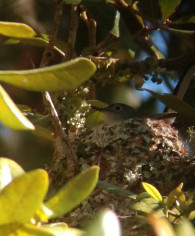 Today on our Birding for Beginner’s trip, evidence of spring and migration were all around us! We saw Great Crested Flycatchers, first-of-year sightings for me and real harbingers of migration. We also found two nests! One was created and tended to by a pair of Osprey and very obvious from where we stood. The other nest we found was much more cryptic and it’s only by sheer luck that we even found it. It was a Blue-gray Gnatcatcher nest. These little birds build little nests using lichens to camouflage it and spider webs to hold it all together. My group and I were all so excited to find it! And we were thrilled to see the little birds taking turns sitting on the nest. One can only assume there’s eggs within! Spring is such a magical time of year, y’all .
Today on our Birding for Beginner’s trip, evidence of spring and migration were all around us! We saw Great Crested Flycatchers, first-of-year sightings for me and real harbingers of migration. We also found two nests! One was created and tended to by a pair of Osprey and very obvious from where we stood. The other nest we found was much more cryptic and it’s only by sheer luck that we even found it. It was a Blue-gray Gnatcatcher nest. These little birds build little nests using lichens to camouflage it and spider webs to hold it all together. My group and I were all so excited to find it! And we were thrilled to see the little birds taking turns sitting on the nest. One can only assume there’s eggs within! Spring is such a magical time of year, y’all .
March 20, 2019 ~ Great Horned Owlet (Meleagris gallopavo)
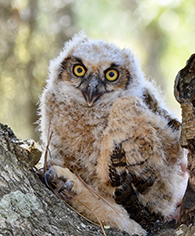 Our naturalists responded to a call yesterday of a Great Horned owlet that had fallen out of its nest. The two adults have taken over an old Bald Eagle’s nest that is about 60 feet up a pine tree. We arrived to find a fledgling hopping around the ground that appeared healthy. To prevent predators such as bobcats from harming the fledgling, we attempted to place the owl on a lower branch. That is when we noticed the owl was holding his leg abnormally and that he had a small abrasion. We decided to take him the The Center for Birds of Prey, a local raptor rehabilitation center where he will hopefully recover and then be released back on Kiawah. We will update you with the status as we hear more! A special thank you to John and Sally Walters who called about the owl and took these amazing photos.
Our naturalists responded to a call yesterday of a Great Horned owlet that had fallen out of its nest. The two adults have taken over an old Bald Eagle’s nest that is about 60 feet up a pine tree. We arrived to find a fledgling hopping around the ground that appeared healthy. To prevent predators such as bobcats from harming the fledgling, we attempted to place the owl on a lower branch. That is when we noticed the owl was holding his leg abnormally and that he had a small abrasion. We decided to take him the The Center for Birds of Prey, a local raptor rehabilitation center where he will hopefully recover and then be released back on Kiawah. We will update you with the status as we hear more! A special thank you to John and Sally Walters who called about the owl and took these amazing photos.
March 12, 2019 ~ Feather Report
Here’s the list for the birds from this morning’s Back Island Birding! It was beautiful out on the East end of the island. Avian life is gearing up for Spring. Anhinga’s are putting on their beautiful breeding plumages, Mergansers are congregating in huge numbers on the ocean, hundreds of Red Knots were bathing in tidal pools, and song birds were busily catching bugs in the morning light. All of the birds are active and most are looking for love!
Willet Pond Look-out; Little Blue Heron, Tricolored Heron, Great Blue Heron, Great Egret, Snowy Egret, Double-crested Cormorant, Fish Crow, Red-winged Blackbird, Boat-tailed Grackle, Blue Jay, Blue-winged Teal, American Coot, Pied-billed Grebe, Laughing Gull, Bald Eagle, Ruby-crowned Kinglet, Hooded Merganser, Belted Kingfisher, Clapper Rail (heard only). Ocean Park Pond: Wood Stork, Anhinga, Yellow-throated Warbler, Pine Warbler, Yellow-rumped Warbler, Blue-gray Gnatcatcher, Carolina Wren (heard only), Northern Cardinal, Downy Woodpecker, Carolina Chickadee, Tufted Titmouse, Northern Mockingbird, Osprey. Ocean Park: Palm Warbler, Chipping Sparrow, Eastern Bluebird, Red-shouldered Hawk, Brown-headed Cowbird (heard only). Ocean Course: Common Gallinule, Lesser Scaup/Greater Scaup (likely we saw both), Song Sparrow, American Crow, Black Skimmer, Forster’s Tern, Caspian Tern, Black-bellied Plover, Wilson’s Plover, Semipalmated Plover, Piping Plover, Dunlin, American Oystercatcher, Ring-billed Gull, Brown Pelican, Red-breasted Merganser, Red Knot, Willet, European Starling. https://ebird.org/view/checklist/S53738327
March 11, 2019 ~ American Turkey (Meleagris gallopavo)
 Turkeys are truly impressive birds with their strong large stature and seemingly fearless nature. Today this hen (which is the name for an adult female turkey) was spotted at Night Heron Park. Turkeys have many names used to describe the relative age and sex of the bird. An adult breeding male is called a Tom; a newly hatched turkey is called a poult or a chick. A juvenile male is called a jake, and a juvenile female is called a jenny. Many people think turkeys are flightless birds; however, wild turkeys are capable of short flights of up to a couple hundred yards at a max speed of 60 mph. And they are very quick on the ground efficiently reaching running speeds of 25 mph. –Naturalist, Jake Goodrum
Turkeys are truly impressive birds with their strong large stature and seemingly fearless nature. Today this hen (which is the name for an adult female turkey) was spotted at Night Heron Park. Turkeys have many names used to describe the relative age and sex of the bird. An adult breeding male is called a Tom; a newly hatched turkey is called a poult or a chick. A juvenile male is called a jake, and a juvenile female is called a jenny. Many people think turkeys are flightless birds; however, wild turkeys are capable of short flights of up to a couple hundred yards at a max speed of 60 mph. And they are very quick on the ground efficiently reaching running speeds of 25 mph. –Naturalist, Jake Goodrum
March 9, 2019 ~ Banded Water SnakeNerodia fasciata
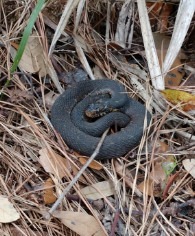 It’s impossible to deny that Spring is nigh. Not only are the birds putting on fantastic, love-fueled displays, but bugs are springing from their wintery refuges, flowers are popping into being, and reptiles are re-entering the scenes. This was evident on our Gator Walk when we stumbled upon my first Kiawah snake of the season – a juvenile banded watersnake (Nerodia fasciata). This little cutie hardly reacted to us as we walked less than a foot away from it and, to be honest, I totally missed it until a guest pointed it out. This species of snake is often mistaken for the venomous cottonmouth for two reasons. First, they spend a lot of time in the water, like cottonmouths (but also like many other aquatic loving snakes). Second, they have a tendency to puff up their heads when threatened. In so doing, they appear to have the triangular head of a venomous snake. We can only assume they’re hoping to ward off any potential predators. In our case, despite our close proximity to the young snake, it never puffed its head. Guess it felt safe and sound with nature lovers around! ~ Naturalist, Juliana Smith
It’s impossible to deny that Spring is nigh. Not only are the birds putting on fantastic, love-fueled displays, but bugs are springing from their wintery refuges, flowers are popping into being, and reptiles are re-entering the scenes. This was evident on our Gator Walk when we stumbled upon my first Kiawah snake of the season – a juvenile banded watersnake (Nerodia fasciata). This little cutie hardly reacted to us as we walked less than a foot away from it and, to be honest, I totally missed it until a guest pointed it out. This species of snake is often mistaken for the venomous cottonmouth for two reasons. First, they spend a lot of time in the water, like cottonmouths (but also like many other aquatic loving snakes). Second, they have a tendency to puff up their heads when threatened. In so doing, they appear to have the triangular head of a venomous snake. We can only assume they’re hoping to ward off any potential predators. In our case, despite our close proximity to the young snake, it never puffed its head. Guess it felt safe and sound with nature lovers around! ~ Naturalist, Juliana Smith
February 22, 2019 ~ Knobbed Whelk (Busycon carica)
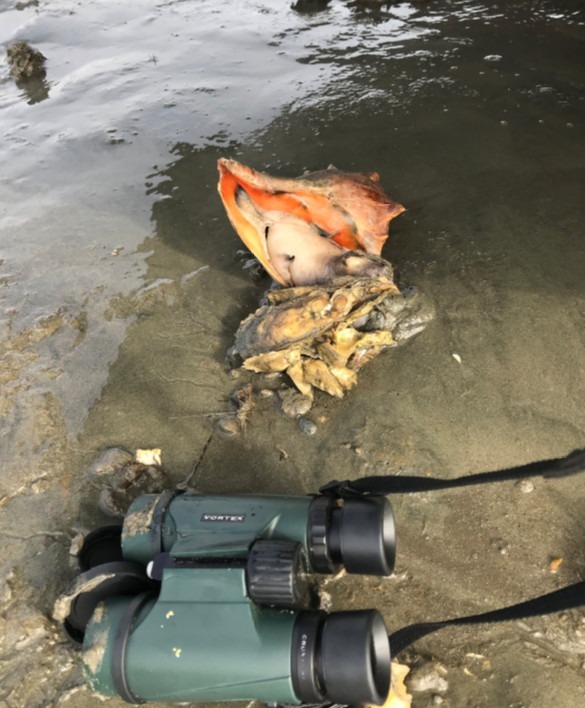 Captain Brad spotted this large Knobbed Whelk snacking on some oysters in the Kiawah River while on a Dolphin Encounters tour. These gastropods use their sharp aperture lip to pry open prey such as oysters, clams, and other bivalves. The snail will slowly chip away at the closed valves until it is able to wedge its foot in between the prey’s shells to begin feeding. You never know what you will see in the Kiawah River!
Captain Brad spotted this large Knobbed Whelk snacking on some oysters in the Kiawah River while on a Dolphin Encounters tour. These gastropods use their sharp aperture lip to pry open prey such as oysters, clams, and other bivalves. The snail will slowly chip away at the closed valves until it is able to wedge its foot in between the prey’s shells to begin feeding. You never know what you will see in the Kiawah River!
February 13, 2019 ~ Bottle-nose Dolphin (Tursiops truncatus)
 Naturalists received a call about two dolphin that were perceived to be stranded at a low tide in a shallow-water creek stemming from the Kiawah River. Hoping for the best, a few Naturalists went to check out the scene. What we found was that the caller and the other passersby were very lucky, as were we! These dolphin weren’t stranded at all but were feeding right underneath the walkway of the bridge over looking Cinder Creek. Dolphin are highly intelligent animals that practice many different feeding behaviors, and it seemed as if these dolphin followed some large fish back into the creek and were having some fun munching on an easy lunch! We were lucky enough to have a front row seat while for quite a while, until the dolphin were all filled up, easily swam underneath the bridge and started making their way back toward the Kiawah River!
Naturalists received a call about two dolphin that were perceived to be stranded at a low tide in a shallow-water creek stemming from the Kiawah River. Hoping for the best, a few Naturalists went to check out the scene. What we found was that the caller and the other passersby were very lucky, as were we! These dolphin weren’t stranded at all but were feeding right underneath the walkway of the bridge over looking Cinder Creek. Dolphin are highly intelligent animals that practice many different feeding behaviors, and it seemed as if these dolphin followed some large fish back into the creek and were having some fun munching on an easy lunch! We were lucky enough to have a front row seat while for quite a while, until the dolphin were all filled up, easily swam underneath the bridge and started making their way back toward the Kiawah River!
February 12, 2019 ~ River Otter (Lontra canadensis)
Usually all one ever expects to see on a birding tour is birds..and maybe a squirrel every now and then. Today, we saw something I never expected to see while leading a land based birding tour, despite the heavy fog that clouded our morning. It all happened while I was trying to point out some Gray Catbirds, a not uncommon bird for Kiawah Island. One of my birders exclaimed that something was in the water. I’ll admit, I assumed it would be an alligator at first and continued to try to describe where the catbirds were, but when I glanced over, what I saw was no reptile, even though it slithered across a mud bank. It was an otter! In a pond! I was totally surprised! We gave up birding for the time being and decided to do some otter ogling. We watched as it slipped silently below the murky pond water. Our eyes followed the trail of bubbles the otter created as it moved below the surface. It, surprisingly, came towards us and sought refuge under the pond’s bank edge right at our feet. We stayed, patiently waiting and watching. Every now and then, we’d see the water begin undulating from where the otter had disappeared below the bank. We even heard what we can only assume were otter vocalizations. At last, our patience was rewarded! A new bubble trail began, indicating the otter was on the move, this time heading away from us and out towards the center of the pond. Near a partially submerged log, the otter surfaced for a breath of air. It was the last we’d see of it, at least for now, but I was completely thrilled. Of all the animals I’ve encountered in my six years at the Nature Program, otters have been the most elusive. I’m excited to have a recent sighting and hope this means more are in the near future! – Naturalist Juliana Smith